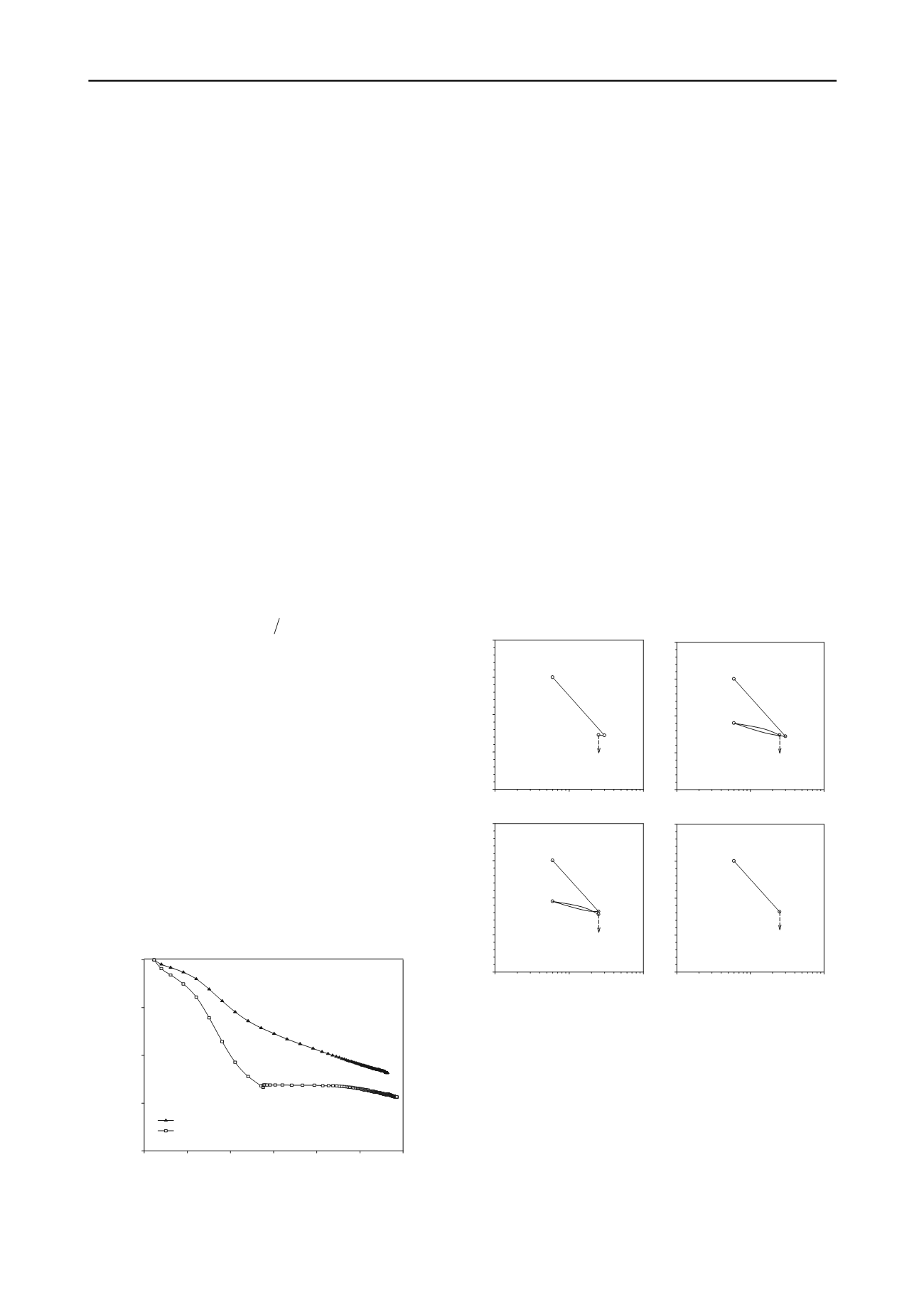
224
Proceedings of the 18
th
International Conference on Soil Mechanics and Geotechnical Engineering, Paris 2013
Proceedings of the 18
th
International Conference on Soil Mechanics and Geotechnical Engineering, Paris 2013
When it is determined during the design stage that seondary
compression settlement is excessive or detrimental, surcharging
technique can be considered for ground improvement to
eliminate part of the undesirable secondary compression
settlement. Surcharging application involves using a temporary
surcharge load in excess of the permanent load. A question can
then be raised as to how much surcharge load is sufficient.
Knowledge about relationship between the magnitude of
surcharge load and the post-surcharge secondary compression
characteristics are required to answer this question. As
discussed earlier, the surcharge load should be removed at the
end of primary consolidation or without leaving excess pore
water in the consolidating soil layer. This renders the soil an
overconsolidation state after rebounding with time. The more
the surcharge load is removed, the higher the overconsolidation
is induced in soil and the longer the time is spent to reach the
end of rebound. Furthermore, it has been clearly observed in
the laboratory that secondary compression may reappear after
the end of rebound. The magnitude of surcharge removal
affects both the time of end of rebound and magnitude of post-
surcharge secondary compression (Mesri and Feng 1991).
Extensive laboratory data of post-surcharge secondary
compression of natural soils, including soft clays, silts, and
peats, show that the magnitude of post-surcharge secondary
compression decreases with increasing the effective surcharge
ratio (Mesri and Feng 1991, Mesri et al. 1997, Mesri et al.
2001). When the surcharge load is removed at the end of
primary consolidation, the effective surcharge ratio is defined
by Eq. (2):
f
f
s
s
R
(2)
where
s
is the effective stress achieved at the end of
surcharging and
f
0
s
is the final effective stress. These data also
show that post-surcharge secondary compression always
appears when the effective surcharge ratio is less than 1.0, is
noticeable for effective surcharge ratios ranging from 0.5 to 1.0,
and becomes important for effective surcharge ratios between
0.1 and 0.5. It is the last case in which post-surcharge
secondary compression settlement may be excessive. Figure 1
shows consolidation curves obtained from laboratory oedimetric
surcharging tests, on a thin-wall tube sample from a lacustrine
clay deposit in Taipei, Taiwan, with a final effective stress of
356 kPa and an effective surcharge ratio of 0.23. It is clearly
seen from Fig. 1 that secondary compression reappears after
surcharge removal and the slope of the post-surcharge
secondary compression curve increases gradually up to a
maximum value, which is about the same as that of the later
portion of the
curve.
R
Time (min)
0.01
0.1
1
10
100
1000
10000
Compression(mm)
0.0
0.2
0.4
0.6
0.8
R' s = 0
R' s = 0.23
Final effective stress 356 kPa
Figure 1. Consolidation curves of Taipei lacustrine clay sample with or
without surcharging
In fact, the execution of surcharging from overburden pressure
to final effective stress could have a number of different stress
histories, as shown in Fig. 2(a)~2(d). Figure 2(a) shows that the
consolidation pressure is increased from the overburden
pressure to the surcharging stress and then unloaded to the final
effective stress. This type of stress history was commonly
adopted in most laboratory surcharging tests. Figure 2(b) shows
that the consolidation pressure is increased from the overburden
pressure to the surcharging stress and then unloaded to the
overburden pressure before reloading to the final effective stress.
This type of stress history depicts a practical situation in which
all preloads, including surcharge load, are removed for the
constrcution of permanent sturctures. Figure 2(c) shows that the
consolidation pressure is increased from the overburden
pressure to the final effective stress without surcharging and
then unloaded to the overburden pressure before reloading to
the final effective stress. This type of stress history depicts a
practical situation in which all preloads, without surcharge load,
are removed for the constrcution of permanent sturctures.
Figure 2(d) shows that the consolidation pressure is increased
from the overburden pressure to the final effective stress
without unloading. This type of stress history represents a
situation that the permanent structure is constructed without
employing precompression technique to reduce secondary
compression. It is noted again that these four types of stress
histories are different but all ended at the same fianl effective
stress. A series of laboratory oedometric surcharging tests with
these stress histories are conducted to study the effects, if any,
of consolidation stress history on secondary compression. Test
results are presented and discussed in this paper.
Consolidation Pressure
Void Ratio
' s
' f
'
v0
Secondary
compression
(a)
Consolidation Pressure
Void Ratio
' s
' f
'
v0
Secondary
compression
(b)
Consolidation Pressure
Void Ratio
' f
'
v0
Secondary
compression
(c)
Consolidation Pressure
Void Ratio
' f
'
v0
Secondary
compression
(d)
Figure 2. Illustrated surcharging stress histories adopted in this study: (a)
unloading from surcharge stress directly to final effective stress, (b)
unloading from surcharge stress to overburden pressure before reloading
to final effective stress, (c) unloading from final effective stress to
overburden pressure before reloading to final effective stress, and (d)
without preloading.
2 LABORATORY SURCHARGING TESTS
2.1
Test program
The surcharging tests are conducted using conventional
oedometer set up with a data acquisition system for taking
LVDT (Linear Variable Differential Transformer) readings of
specimen compression. The soil tested is a native organic clay


